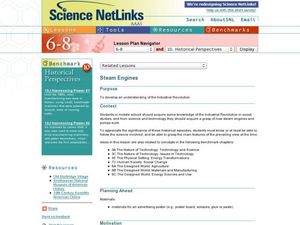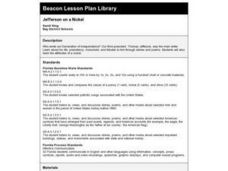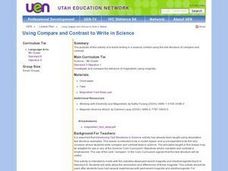Curated OER
Natural Disasters
Students investigate why natural catastrophes occur around the world and the results of such catastrophes. They investigate how people recover from catastrophes and can they be prevented. Students create their own work of art depicting a...
Curated OER
Sorting Quadrilaterals
Tenth graders investigate the geometric concept of quadrilaterals. They are given a set of shapes and asked to sort the quadrilaterals from the others. Then working in pairs they discuss the characteristics and write down the description...
Curated OER
Replicating Controversy
Student act as a research scientists and investigate the development of animal and human cloning. They then report their findings, both orally and visually, to their "colleagues" at a symposium on cloning research. Students explore the...
Curated OER
Wetland Metaphors
Students are presented with a selection of hands on objects for investigation as metaphors for natural functions of wetlands. A 'Mystery Metaphor Container' is presented to the class with everything having to do with a wetland in some...
Curated OER
Problem Based Learning
Students increase problem solving skills. They research computer-related crimes, classifying them into the types of crimes. Students create a crime report. They present a presentation to the class.
Curated OER
Line Symmetry
Students investigate the concept of line symmetry and how to recognize it in different contexts. They record the number of symmetries when given problems to work on in class. They review the concept of congruence and how it relates to...
Curated OER
Creepy Crawlies
Second graders study the world of insects. They join Greenpatch Kids, an organization of young people who are interested in nature and want to protect our environment. In addition, the students assess use of technology as a valuable...
Curated OER
Athabaskan Migration & Bering Strait
Young scholars study Athabaskan migration patterns and the Bering Strait Land Bridge theory. They investigate the importance of the expansion of trade and compare the differences between American Indian oral tradition accounts of...
Curated OER
Anti-Semitism Throughout the Ages
Learners investigate the implication of anti-Semitism. In this prejudice lesson, students compare anti-Semitism to bullying as they research the propaganda techniques employed during the Holocaust and throughout history.
Curated OER
Let's Be Honest!
Students investigate the concepts of honesty and take a survey about honesty. They use the New York Times to conduct research to identify the characteristics commonly found in stories about cheating. Students write reflective papers...
Curated OER
Steam Engines
Students investigate the invention of the steam engine. In this technology lesson, students investigate the advancement of technology over time. They relate science and technology together.
Curated OER
Understanding the Power of Genes
Young scholars research the impacts of genetic research on homes, research laboratories, and hospitals. For this genetics lesson, students use the Internet to investigate the ways that genetics has affected our way of life. They present...
Curated OER
Understanding Effectiveness
Students investigate the work of animal welfare advocates. In this advocacy lesson, students examine advocacy strategies and investigate their effectiveness as they analyze King's "I Have a Dream" speech. Students apply the advocacy...
Curated OER
Hurricanes and Climate
Students investigate maps and data to learn about the connections between hurricanes and climate. In this exploratory lesson students describe and graph the 6 regions where hurricanes happen and discuss how hurricanes have changed over...
Curated OER
I Wood if I Could
Tenth graders investigate the process of how specific products are made from trees. For this chemistry instructional activity, groups of students must choose among ice cream, bubble gum, paper, toothpaste and lipstick. They research,...
Curated OER
The Moon Made Me Do It!
Pupils research lunar cycles and how it effects living organisms. In this investigative lesson students prepare written reports on the lunar cycles and the relationship between animal behavior and reproductivity then give an oral...
Curated OER
What Part of the Earth's Surface is Covered by Oceans?
Third graders investigate oceans. In this Earth science lesson, 3rd graders predict how much of the Earth's surface is covered by oceans. Students determine if their predictions are accurate by throwing a globe to each other and then...
Curated OER
Bulldozers at the Door
Students investigate current event issues in Zimbabwe. For this global issues lesson, students visit selected Web sites to determine why thousands of citizens were evacuated from their homes. Students examine the bureaucratic upheaval...
Curated OER
Metis- Grade 9
Ninth graders investigate aspects of Metis life. In this Canadian history lesson, 9th graders research Metis life and use their findings to create time line quilts.
Curated OER
Energy Inspiration Document and Website Production
Seventh graders conduct a web quest to find information on types of energy found in US. In this earth science lesson, 7th graders investigate the environmental consequences of using these resources. They develop a creative presentation...
Curated OER
Density and Buoyancy Lesson Plan
High schoolers investigate why some objects float or sink in water. For this physics lesson, students calculate the density of clay ball using a mathematical equation. They write a complete lab report about the experiment.
Curated OER
Chaucer's Wife of Bath
Students analyze Chaucer's portrayal of the Wife of Bath in The Canterbury Tales. Students prepare class reports on the institution of marriage and the place of women in the Medieval society.
Curated OER
Jefferson on a Nickel
Students study our third president, Thomas Jefferson through stories and poems. They investigate the attributes of a nickel.
Curated OER
Using Compare and Contrast to Write in Science
Fifth graders investigate and compare the behavior of magnetism using magnets. In this physics lesson, 5th graders write about the similarities and differences of a variety of magnet types.

























